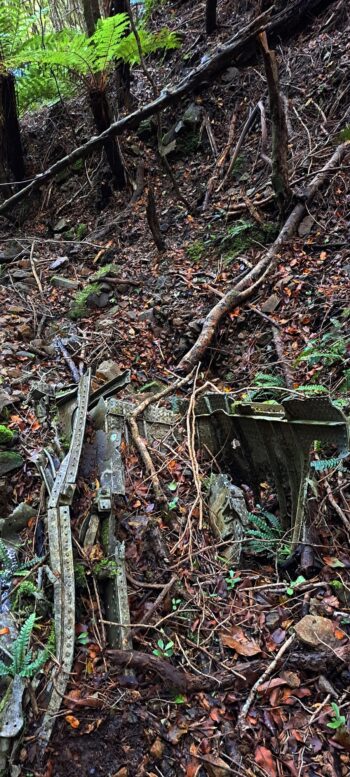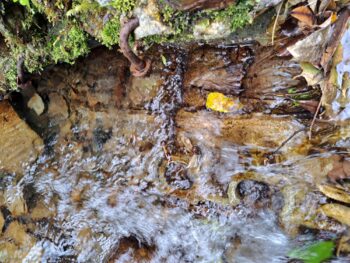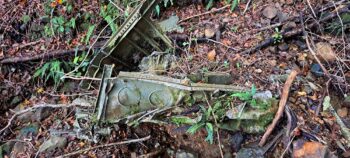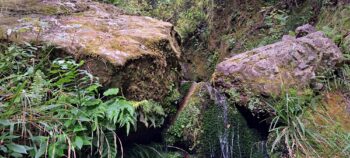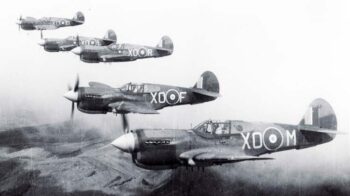The story of the kittyhawk plane crash and subsequent wreckage located in Wainuiomata
Kittyhawk plane serial number 3031
 The Kittyhawk, also known as the Curtiss P-40 Warhawk, was manufactured by Curtiss-Wright Corporation in Buffalo, New York. The aircraft, identified by Constructors Number 19957, underwent several assignments: initially, it belonged to the U.S. Army as serial number 41-36124, then as RAF serial number ET770, and was later reassigned to the Royal New Zealand Air Force (RNZAF) as Kittyhawk serial number NZ3031 for 16 Squadron, coded XO-R, stationed at Fairhall, the satellite airfield of Woodbourne.
The Kittyhawk, also known as the Curtiss P-40 Warhawk, was manufactured by Curtiss-Wright Corporation in Buffalo, New York. The aircraft, identified by Constructors Number 19957, underwent several assignments: initially, it belonged to the U.S. Army as serial number 41-36124, then as RAF serial number ET770, and was later reassigned to the Royal New Zealand Air Force (RNZAF) as Kittyhawk serial number NZ3031 for 16 Squadron, coded XO-R, stationed at Fairhall, the satellite airfield of Woodbourne.
Kittyhawk plane crash
 On 1 May 1943, twenty three year old Sergeant Thomas Victor Marchant (Tom), service number 421076, RNZAF, piloted his Curtiss P-40E Kittyhawk during a training flight heading north from Baring Head. The plane crashed into a hillside in Wainuiomata.
On 1 May 1943, twenty three year old Sergeant Thomas Victor Marchant (Tom), service number 421076, RNZAF, piloted his Curtiss P-40E Kittyhawk during a training flight heading north from Baring Head. The plane crashed into a hillside in Wainuiomata.
Tom’s last communication via radio was received at 2:12 PM, indicating that the crash likely occurred minutes later. According to reports, the plane hit a downdraft, pancaked and hit a rock face then exploded into flames leaving wreckage scattered over half a mile and the engine broke away and rolled down a gully. The plane only needed a 100 feet or so to make it over the ridge. At the time of the crash, the aircraft was fully armed and loaded with much of the ammunition being scattered by the blast. The aircraft sustained irreparable damage and was officially classified as written off and left sitting near the top of the hillside.
Marchant, who had won his wings only eight months prior, was killed instantly with his remains recovered two days later, by a party of police and airmen. He now rests in peace at Aramoho Cemetery in Wanganui.
Location of the Kittyhawk crash site
 Today, the precise crash site has likely been identified. Located below the McKerrow Ridge above Sunny Grove, specifically within the valley where Skerretts Creek descends, the low vegetation on the hillside in that area suggests it as the location. Furthermore, the plane hit a rock face and caught fire then exploded and there are only two known locations here with a rock face, and only one contains buried plane parts.
Today, the precise crash site has likely been identified. Located below the McKerrow Ridge above Sunny Grove, specifically within the valley where Skerretts Creek descends, the low vegetation on the hillside in that area suggests it as the location. Furthermore, the plane hit a rock face and caught fire then exploded and there are only two known locations here with a rock face, and only one contains buried plane parts.
The two rock faces are positioned on a narrow spur with steep slopes, making it likely for wreckage to fall into the upper arms of Skerretts Creek. This suggests that the rock face containing parts, which is the highest known location with plane debris, is the actual crash site. An eyewitness, who has seen the crashed plane, supports this claim. Moreover, old photographs of the plane wreckage and the surrounding landscape match the topography of this known debris site.
The exact location of the crash site was not much of a secret in times passed though. In fact the site was visible for many years as the ensuing fire marked the hillside for years after the crash, and could be seen from Wainuiomata Road when traveling over Wainuiomata Hill. In time however, nature reclaimed the site and it is now deeply hidden in dense vegetation making it very difficult to find.
Known Kittyhawk wreckage and parts
 Over the decades, a significant portion of the wreckage scattered across the hillside and creek has been taken away by people seeking a piece of history or memorabilia. This included guns, the console panel, ammo, and basically anything that could be carried out.
Over the decades, a significant portion of the wreckage scattered across the hillside and creek has been taken away by people seeking a piece of history or memorabilia. This included guns, the console panel, ammo, and basically anything that could be carried out.
In 1958, an apple box full of ammunition was handed in to the police and two groups of school boys took .5 inch machine guns out. Also, Selwyn Torrence took a gun and cleaned off the rust. The Gembitsky brothers also salvaged a gun and a quantity of ammunition. These items were later confiscated and apparently cut up. A month later, RNZAF’s former Director of Works, WG Cmdr J.M. Carr, trekked to the site and recovered more ammunition that had been uncovered by rain.
Despite these documented cases and many others that have not been recorded, remnants still exist, typically consisting of pieces deemed too cumbersome or sizable for removal. Today, numerous sites still contain scattered parts of the wreckage. Known remaining pieces include the V12 Allison motor, landing gear, fuselage fragments, propeller hub, wing sections, and some engine bearers.
Undoubtedly, some parts remain undiscovered, likely buried by landslides. Other fragments may have been swept far downstream during floods, possibly ending up in backyards along Sunny Grove, or even carried further into the Wainuiomata River, where they would blend in with other debris.
Locations of the remaining Kittyhawk wreckage
 Over the years, the wreckage has been dispersed across multiple locations due to river flow, floods, and slips. Despite numerous attempts by individuals to locate the wreckage, finding even a single piece of the plane can prove difficult. Even if you are given instructions on the locations, it is still difficult to find. This is further compounded by the constant movement of parts down the valley. One could stumble upon a fragment of the wreckage, only to return the following year and find it displaced once again. The latest whereabouts of most sites are known to only a few who are up to date with the locations.
Over the years, the wreckage has been dispersed across multiple locations due to river flow, floods, and slips. Despite numerous attempts by individuals to locate the wreckage, finding even a single piece of the plane can prove difficult. Even if you are given instructions on the locations, it is still difficult to find. This is further compounded by the constant movement of parts down the valley. One could stumble upon a fragment of the wreckage, only to return the following year and find it displaced once again. The latest whereabouts of most sites are known to only a few who are up to date with the locations.
While venturing into the valley in search of wreckage often leads to disappointment, as demonstrated in this video, the valley lacks a designated track, making the journey somewhat arduous. It traverses treacherous terrain in some sections, requiring climbing up or down ravine walls, to ascend or descend numerous waterfalls. There is even a cliff face to negotiate. At the crash site, the steep slope has caused large trees to slide down the hillside, highlighting the instability of the terrain. In summary, although some wreckage sites are more accessible than others, the absence of a proper walking trail can be challenging even under the best conditions.
Removing the wreckage
The Department of Conservation (DOC) upholds a policy of preserving plane wrecks to honour their historical significance and out of respect for those who perished. Unauthorized removal of historic artifacts, including plane wreckage, from public lands is prohibited, with DOC issuing stern warnings for such actions. Further, the New Zealand Defence Force asserts ownership of the Wainuiomata wreckage and prohibits the removal of any parts.
Special thanks to Lance Stewart for some of the detail in this article.
Special thanks to Tony Weir for his help in locating the main wreckage sites.
Special thanks to Martin Gembitsky (eye witness of the plane crash site) for confirming the crash site location.


